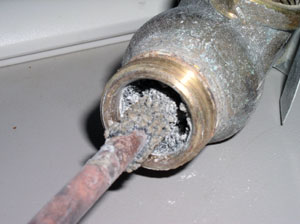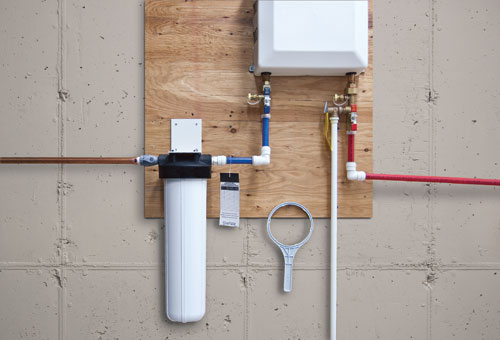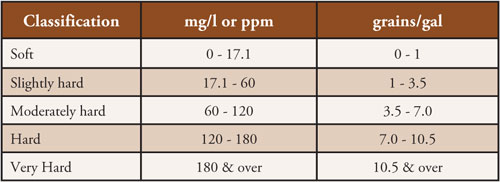Media-Assisted Crystallization

Photo courtesy of Watts
Example of scale build-up on a water heater's temperature and pressure valve. Scale can lead to malfunctions and potentially dangerous explosions of heaters with clogged pressure valves.
Scale accumulation in water heaters can lead to an increased energy usage by up to 24 percent.
The problem of scale in commercial buildings has an exponential impact on maintenance. Scale can cause the premature replacement of equipment. Hard scale can accumulate over time on pipes, valves, fixtures and heating elements causing a multitude of problems. Scale deposits are insoluble making scale extremely difficult to remove. Once formed, scale often leads to costly remediation efforts. As scale forms, it reduces the inner diameter of pipes causing restrictions in flow rate and pressure loss problems in mechanical systems. Scale often becomes encrusted on the internal moving parts of valves and components potentially causing safety failures. For example, in a boiler or hot water tank, heating elements that become coated with scale reduce system efficiency and increase operating costs for end users. Reducing the impact of scale on mechanical systems affects the energy use of the building and is part of an integrated sustainable design strategy for buildings.
The Water Research Council classifies water supplies based on how many grains of hardness per gallon of water (g.p.g.) Measurements by grain dates to the Bronze Age as a unit of measured mass roughly based on the mass of a single seed of wheat. The chart below lists the classifications used to determine water hardness or softness.
General patterns of hardness in the United States can be found on a map developed by the U.S. Geological Survey and a map can be found on their website.2 The softest waters are found in parts of New England, the South Atlantic-Gulf States, the Pacific Northwest, and Hawaii. Moderately hard waters are common in many rivers of Alaska and Tennessee, in the Great Lakes region, and the Pacific Northwest. Hard and very hard waters were found in some streams in most of the regions throughout the country. Hardest waters (greater than 1,000 mg/L) were measured in streams in Texas, New Mexico, Kansas, Arizona, and southern California. Information on how to find out about local drinking water quality can be found on the EPA website.3 |
Solutions That Cause Environmental Challenges
Although some areas of the United States have naturally soft water sources, the most plentiful sources of fresh water are rich in minerals and can be classified to varying degrees of hardness. Conventional treatments include the installation of a water softener that removes the hard water minerals that can cause scaling. Unfortunately, softening typically causes a poor taste in the water and elevates the sodium level of the treated water, which may be a health issue for some people. Water softening is not the same as MAC. Softening is a process that removes scale forming calcium and magnesium hardness ions from water and replaces them with non-scale forming sodium ions through a process known as ion exchange. Periodically the softening system must regenerate itself with a sodium chloride brine solution to restore its sodium ion content thus allowing further softening to take place.
Ion exchange water softeners discharge brine elevated in calcium, magnesium and chlorides into wastewater systems increasing the challenges and costs of water re-use. Although effective in controlling scale formation of water delivered to the consumer, discharge from these systems results in elevated levels of salt deposited back into the environment. Water flushed from these systems has high concentrations of salinity in their total dissolved solids (TDS), which consequently affects the purity of the fresh water supply. This is causing a crisis for communities that have seen a rise in the costs for water treatment because of this common practice.
TDS (salinity) is a measurement of total dissolved solids in water including inorganic (hardness, salts) and organic substances (pesticides, herbicides, etc.). The sources of salinity in water include:
Water reuse is a water conservation practice in which reclaimed water is used for a direct beneficial purpose. As examples, Arizona researchers identified the effect of TDS on water reuse to agriculture and to buildings. TDS can affect crop salt tolerance and yields and increase the need for additional water for irrigation to flush salts from root zones. It can also increase water usage by cooling towers and cause energy loss and equipment damage due to scaling. |
MAC Media
A specially designed catalyst is coated on the surface of the MAC media which reduces bicarbonate. This reduction in bicarbonate causes calcium and magnesium to precipitate out of the water as nano-sized particles before they can grow into scale.

Photo courtesy of Watts
Media-assisted crystallization water conditioners are ideal for protecting tankless hot water heaters. This image demonstrates the copper connection from the water source through the MAC unit and into the heater.
This process of water conditioning results in the creation of what might be considered “soft scale.” These nano-sized microscopic crystals of scale (seed crystals), rapidly form in the treated water, not on the contact surfaces of the water system, and are carried downstream in colloidal suspension through the water system.
- In untreated water, the scale forms on the inside walls of pipe, exterior of fixtures and all heating surfaces.
- In MAC treated water, the seed crystals themselves provide a far greater surface area for new scale formation. Therefore, new scale preferentially deposits on this continuously replenished stream of suspended crystals rather than on the water contact surfaces—especially those surfaces that are at elevated temperatures and ultimately flow down the drain.
The National Gallery of Art in Washington, DC, is a sprawling complex of buildings, underground tunnels and landscape gardens. The West wing of the galleries was designed by John Russell Pope in 1941 and is connected by an underground tunnel to the award winning East Wing, designed by I.M. Pei in 1978. Visitors to the galleries lunch in part of the underground building in front of a large, exposed water fall little knowing that this symbolic fountain also represents a complex interaction of nature with the built environment. The buildings, adjacent ice rink and gardens are engineered to use water for many multi-layered purposes. When the East Wing was built, the water system was re-engineered for both buildings. Bulk water from the DC water supply was piped to makeup water loss in their large chilled water system. Chilled water is used in air washers for temperature control and humidification throughout the gallery. Historically a non-chemical treatment approach was used on the bulk chilled water with concern to protect the fragile and valuable artwork in the buildings. Twenty years later, to address maintenance concerns that included the accumulation of scale and pipe corrosion, engineers began to investigate 21st century alternatives to find the best environmental alternatives for water quality while continuing to protect their concerns for air quality. According to Keith Karl, the president of Water Resources Group, the unique challenges of this project required a multi-layered approach to the design of the water conditioning system. After analyzing the source water from the D.C. water supply and the bulk circulating chilled water, their team realized that they could not use conventional treatments for biological contaminants, corrosion and scale because of the fear of having chemical fumes in the air stream for the gallery. After extensive research, they chose a media-assisted crystallization (MAC) water conditioning system to be installed on the incoming city water used to makeup the chilled water supply. This new product excels in the prevention and removal of scale, by incorporating a technology similar to a biomechanical process, to control scale formation, without the use of chemicals and without the waste typically needed by systems that have to regenerate. The MAC system was smaller than conventional water conditioning or softening units and requires very little maintenance. A MAC system transforms the dissolved calcium in the hard City water as it is introduced into the building, into harmless calcium carbonate particles. As a preliminary study of the effectiveness of a MAC water conditioning system, engineers piloted a 30-day study on one of the air washers. They tested for water quality, odors and calcium carbonate scale. In this trial, all aspects of water quality improved and there was an immediate and estimated twenty percent reduction of scale. This test led to the engineering of additional systems that include the large lunchroom waterfall as well as conditioned water delivered to the ice skating rink and HVAC comfort cooling system. All of the water for the complex is treated to reduce scale. In addition, as part of a multi-layered approach to water conditioning, microbial sand vortex filters and ultraviolet treatments condition water for additional high-use areas in the facilities to assure the removal of all biological contaminates. This sustainable approach allows for specific water treatments by use in the facility. The MAC unit requires less space and has the environmental advantages of reducing maintenance costs while increasing the longevity of the plumbing system. The MAC system has also improved energy efficiency of the mechanical equipment and lowered energy costs. |










